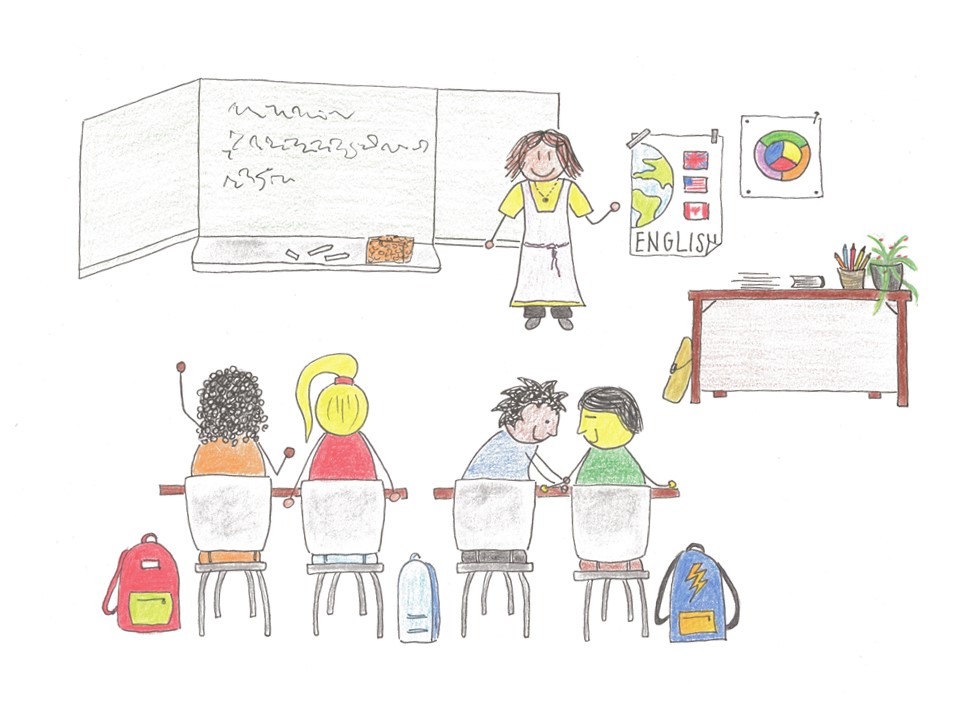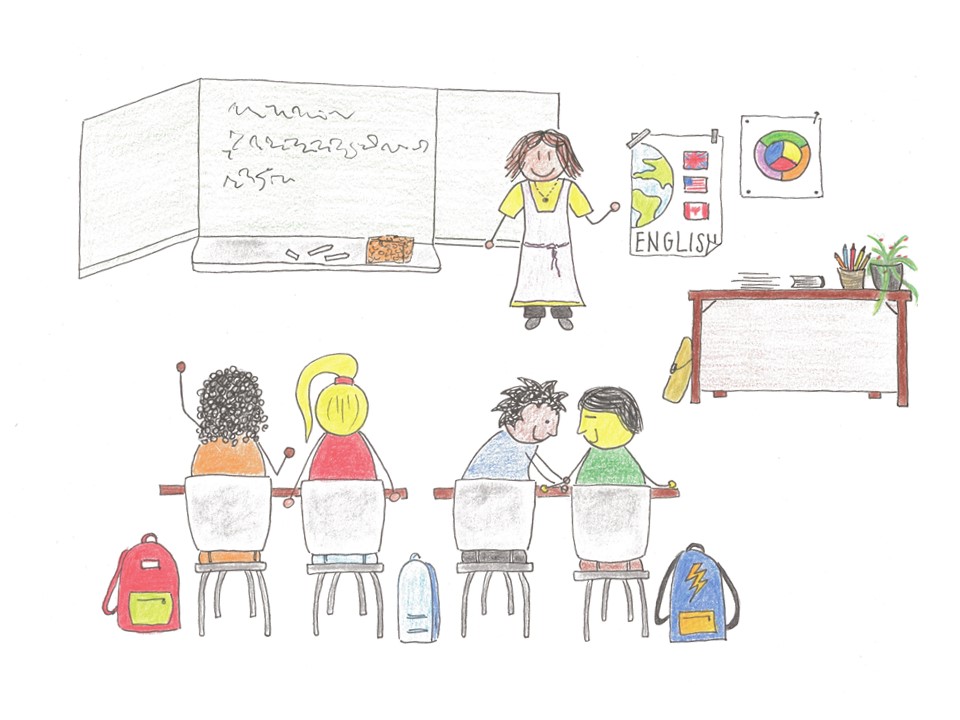In the classroom
| Website: | QUA-LiS NRW |
| Kurs: | [Q23] At school |
| Buch: | In the classroom |
| Gedruckt von: | Gast |
| Datum: | Donnerstag, 18. Dezember 2025 |
Beschreibung
1. Grammar - The verb "to be"
The verb "to be" has three different forms:
Das Verb "to be" hat drei verschiedene Formen:
💡 form (Form):
| subject | form of "to be" | German | |
|---|---|---|---|
| I | -> | am | ich bin |
| you (Sg.), |
-> | are | du bist |
| he, she, it | -> | is | er, sie , es ist |
| we | -> | are | wir sind |
| you (Pl.), |
-> | are | ihr seid |
| they |
-> | are | sie (Pl.) sind |
| I | am | a pupil. | Ich bin ein Schüler. |
| You | are | a teacher. | Du bist ein Lehrer. |
| He | is | tired. | Er ist müde. |
| She | is | a nice girl. | Sie ist ein nettes Mädchen. |
| It | is | 8 o'clock. | Es ist 8 Uhr. |
| We | are | a great class. | Wir sind eine tolle Klasse, |
| You | are | my friends. | Ihr seid meine Freunde. |
| They | are | in the classroom. | Sie sind in der Klasse. |
📌 remember! (Merke dir!)
When the subject is a pronoun (I, you, he, she, it, we, you, they), you can also use the short forms:
Wenn das Subjekt ein Pronomen (I, you, he, she, it, we, you, they) ist, dann kann man auch die Kurzform verwenden:
I'm a pupil.
You're a teacher.
He's tired.
She's a nice girl.
It's 8 o'clock.
We're a great class.
You're my friends.
They're in the classroom.
1.1. Sorting - The right form of "to be"
learningapps.org: Cookies
1.2. Gap text
learningapps.org: Cookies
1.3. Fill in *
learningapps.org: Cookies
1.4. Write the short/ long form
learningapps.org: Cookies
2. Grammar - Negative statements
The verb "to be" in negative statements:
Das Verb "to be" in Verneinungen:
I am not silly.
He is not tired.
We are not lazy.
You insert the word "not" after the verb "to be". Here you can also use the short form:
Man fügt das Wort "not" ("nicht") hinter dem Verb "to be" ein. Hier kann man auch die Kurzform verwenden:
He isn't tired
We aren't lazy.
but (!): I'm not silly.
2.1. Write a negative statement
learningapps.org: Cookies
2.2. Gap text
learningapps.org: Cookies
3. Grammar - Questions
Questions with the verb "to be"
1. yes-no questions:
You put am / is / are at the beginning of the sentence:
Man setzt am / is / are an den Anfang des Satzes:
| statement: | I | am | nice. |
| question: | Am | I | nice? |
| statement: | He | is | tired. |
| question: | Is | he | tired? |
| statement: | We | are | great kids. |
| question: | Are | we | great kids? |
You answer to a yes-no question with a short answer:
Man beantwortet eine Ja / Nein-Frage mit einer Kurzantwort:
| Yes, | I | am. |
| you / we / they | are. | |
| he / she / it | is. |
(no short forms possible!)
or
| No, | I' | m not. |
| you / we / they | aren't. | |
| he / she / it | isn't. |
(short forms necessary!)
2. Wh-questions:
Put the question word (who / where / what / why / when) at the beginning of the question:
Setze das Fragewort (who / where / what / why / when) an den Anfang der Frage:
Who is the teacher?
Where is the school?
What is in the schoolbag?
When is football training?
Why are you late?
3.1. Memory - Questions and answers
learningapps.org: Cookies
3.2. Fill in *
learningapps.org: Cookies
4. Vocabulary - Text: Noah is dreaming
| English | German | Notes |
|---|---|---|
| Monday |
(der) Montag | Write something that helps you to learn. |
| 8 o'clock |
acht Uhr | |
| tired |
müde | |
| to stand |
stehen | |
| to talk |
sprechen | |
| maths |
Mathe | |
| interested |
interessiert | |
| boring |
langweilig | |
| difficult |
schwierig | |
| PE |
Sport (als Unterrichtsfach) | |
| to daydream |
tagträumen | |
| to come |
kommen | |
| perhaps |
vielleicht | |
| answer |
(die) Antwort | |
| to smile |
lächeln | |
| to look |
schauen | |
| face |
(das) Gesicht | |
| to turn red |
rot werden | |
| I am sorry. |
Es tut mir leid. | |
| suddenly |
plötzlich | |
| the bell rings |
es klingelt | |
| to raise a hand |
eine Hand heben | |
| to explain |
erklären |
4.1. Dialogue Cards
4.2. Flashcards
4.3. Reading - Noah is dreaming
Read the text and listen to the audio. The words in the vocabulary list will help you to understand.
Lies den Text und höre dir das Audio an. Die Worte in der Vokabelliste helfen dir, ihn zu verstehen.
Slow version:
Monday morning at Adderbury High School
It’s 8 o’clock on Monday and Noah is very tired. His teacher Mr Johnson is standing in front of the class and talking about maths. But, Noah isn’t interested in maths. Maths is so boring and difficult. Noah loves English and PE.
Noah isn't listening to his teacher, he is daydreaming. This morning he is dreaming about Nina. She is nice and likes hip hop, football, and Noah’s favourite boy group! “Nina is coming to my birthday party! Perhaps I can dance with her,” Noah is smiling.
“Noah! Do you know the answer?” his teacher asks. The teacher is looking at Noah, Noah’s face is turning red. “I’m sorry Mr Johnson. I don’t know the answer, I think it is too difficult for me!” “No, Noah, it’s not too difficult. You are daydreaming in class. You are not listening to me!” Suddenly, the bell rings. Noah is happy.
4.4. True or false?
4.5. Gap text *
learningapps.org: Cookies
4.6. Read and record
Read the text out loud and make a recording.
Lies den Text laut und mache eine Tonaufnahme.
Here you can listen to the text again before you start.
Hier kannst du dir den Text vorher noch einmal anhören.
Slow version:
Monday morning at Adderbury High School
It’s 8 o’clock on Monday and Noah is very tired. His teacher Mr Johnson is standing in front of the class and talking about maths. But, Noah isn’t interested in maths. Maths is so boring and difficult. Noah loves English and PE.
Noah isn't listening to his teacher, he is daydreaming. This morning he is dreaming about Nina. She is nice and likes hip hop, football, and Noah’s favourite boy group! “Nina is coming to my birthday party! Perhaps I can dance with her,” Noah is smiling.
Do you know the answer?” his teacher asks. The teacher is looking at Noah, Noah’s face is turning red. “I’m sorry Mr Johnson. I don’t know the answer, I think it is too difficult for me!” “No, Noah, it’s not too difficult. You are daydreaming in class. You are not listening to me!” Suddenly, the bell rings. Noah is happy.
5. Grammar - Present progressive
Present Progressive (Verlaufsform der Gegenwart)
📝 rule:
You need the present progressive when you say, what someone is doing now / at the moment.
Mit dem Present Progressive kannst du sagen, was jemand gerade (now) tut oder was im Moment (at the moment) passiert.
💡 form:
| am | + verb | + ing |
| are | ||
| is |
✏️ example:
| singular | |
|---|---|
| I am watching TV. | - Ich gucke (gerade) Fernsehen. |
| You are learning English. | - Du lernst (gerade) Englisch. |
| He is reading a book . | - Er liest (gerade) ein Buch. |
| She is eating pizza. | - Sie isst (gerade) Pizza. |
| It is watching Joyce. | - Es beobachtet (gerade) Joyce. |
| plural | |
| We are doing our homework. | - Wir machen (gerade) Hausaufgaben. |
| You are playing football. | - Ihr spielt (gerade) Fußball. |
| They are drinking water. | - Sie trinken (gerade) Wasser. |
💡 short forms:
With personal pronouns you can also use short forms: I'm, you're, he's, she's, it's, we're, you're, they're
In Verbindung mit Personalpronomen kann man auch die Kurzform verwenden.
⚠️ attention:
If the verb ends with an ~e, you must leave it out in the progressive form.
Endet das Verb auf ~e, fällt es in der Verlaufsform weg.
dance → dancing
make → making
If the verb ends with a short vowel and a consonant, you must double the consonant in the progressive form.
Endet das Verb mit einem kurzen Vokal und einem Konsonant, musst du den Konsonant in der Verlaufsform verdoppeln.
sit → sitting
stop → stopping
📌 remember:
There is no present progressive in German.
Das Present Progressive ist eine Zeitform, die es im Deutschen nicht gibt.
💥 signal words:
now, at the moment
5.1. Fill in the gaps

learningapps.org: Cookies
5.2. Multiple choice

learningapps.org: Cookies
5.3. Fill in the gaps

learningapps.org: Cookies
5.4. Write sentences
learningapps.org: Cookies
6. Grammar - Negative statements (present progressive)
You add the word "not" to the sentence to make it negative.
Du fügst du das Wort "not" hinzu, um den Satz zu verneinen.
💡 form:
| am | not | + verb | + ing |
| are | |||
| is |
✏️ example:
| singular | |
|---|---|
| I am not watching TV. | - Ich gucke (gerade) kein Fernsehen. |
| You are not learning English. | - Du lernst (gerade) nicht Englisch. |
| He is not reading a book . | - Er liest (gerade) kein Buch. |
| She is not eating pizza. | - Sie isst (gerade) keine Pizza. |
| It is not raining. | - Es regnet (gerade) nicht. |
| plural | |
| We are not doing our homework. | - Wir machen (gerade) keine Hausaufgaben. |
| You are not playing football. | - Ihr spielt (gerade) kein Fußball. |
| They are not drinking water. | - Sie trinken (gerade) kein Wasser. |
Short form:
Kurzform:
| I'm not | + verb | + ing |
| you aren't | ||
| he isn't | ||
| she isn't | ||
| it isn't | ||
| we aren't | ||
| you aren't | ||
| they aren't |
6.2. Write the correct form *

learningapps.org: Cookies
7. Grammar - Questions (present progressive)
There are two kinds of questions:
1. yes-no questions:
You put am / is / are at the beginning of the sentence:
Man setzt am / is / are an den Anfang des Satzes:
| statement: | I | am | watching | TV. |
| → question: | Am | I | watching | TV? |
| statement: | He | is | reading | a book. |
| → question: | Is | he | reading | a book? |
| statement: | We | are | doing | our homework. |
| → question: | Are | we | doing | our homework? |
You answer to a yes-no question with a short answer. There is NO verb + ~ing in a short answer!
Man beantwortet eine Ja / Nein-Frage mit einer Kurzantwort. Das Verb + ~ing wird in der Kurzantwort nicht wiederholt!
| Yes, | I am. |
| you / we / they are. | |
| he / she / it is. |
(no short forms possible!)
| No, | I'm not. |
| you / we / they are n't. | |
| he / she / it is n't. |
(short forms necessary!)
2. Wh-questions:
Put the question word (who / where / what / why / when) at the beginning of the question:
Setze das Fragewort an den Anfang der Frage:
| statement: | I | am | watching | A VIDEO. | |
| → question: | WHAT | am | I | watching | ? |
| statement: | He | is | reading | a book IN THE KITCHEN. | |
| → question: | WHERE | is | he | reading | a book? |
7.1. Gap text

learningapps.org: Cookies
7.2. Gap text *

learningapps.org: Cookies
7.3. Dictations * - questions

learningapps.org: Cookies
7.4. Translate **

learningapps.org: Cookies
8. Your text and creative task
Look at the picture and write sentences about what is happening in the classroom in your notebook. The phrases can help you.
Schau dir das Bild an und schreibe Sätze dazu, was dort passiert in dein Heft. Die Satzteile können dir helfen.

... is standing ...
... is raising her hand...
... is wearing.
... are talking.
... is asking.
There is ... on ...
There is ... next to ...
or: Draw a picture of your class and write a text about it. Upload it in the school-WIKI.
oder: Zeichne ein Bild von deiner Klasse und schreibe einen Text dazu. Lade ihn ins school-WIKI hoch.
